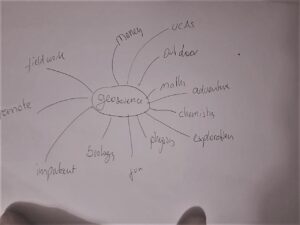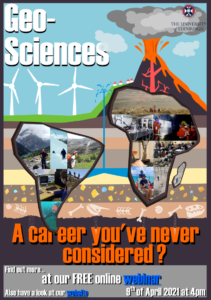The process behind the poster
Thoughts behind the poster
To raise awareness for my project I always knew I would have to make a poster of some kind. A poster that is not only eye-catching, but a poster that tells the viewer immediately what it is about. This poster had to bring a message across. In a world where society, especially younger society is driven towards visual media, I knew I had to include graphics that were out of the ordinary and ones that told a story. I wanted to use as few words as possible and let the images speak for themselves.

Every poster starts with a map of ideas. What is the message I want to achieve (source: Leonluca Klein).
After mind mapping all the ideas on a page, I realised how uncertain the future of our generation was. I knew in order to appeal to these uncertain times my message had to be hopeful and inspiring. Job prospects in the wake of the pandemic, climate and political crisis blur the clarity of their future. With the lack of exposure to geoscience, most Scottish pre-university students are subjected to the influence of their surroundings and the media. The media often associates climate change, the oil industry and geologist together with other geoscientists as the culprits for the climate crisis. The narrative is driven by a wide range of factors including the oil boom and the industry’s strong lobbying ability often gets media coverage. As well as the news of oil spills.
Evolution of the poster

The first draft of the poster. All key ideas are present here (source: Leonluca Klein).
Imagery
The poster here tries to link geo-processes with industries. The volcanic eruption is a nod to volcanologist, drawing from familiarity. Most people will know these fields of study either from the news, films and school. The volcanic eruption represents the dynamic and forceful nature of the Earth and how powerless we are to it if we don’t understand and predict it. Engineering and geoscience go hand in hand, and with the increased demand for renewables, geoscientists are needed. Water spouting from a confined aquifer adjacent to small houses shows the significance of water in today’s society. It is here because it is often easy to forget the complexity and value of fresh clean drinking water when you come from the West. With time, fresh drinking water sources will be dwindling as the agricultural output tries to keep up with the growing global population. Again, palaeontology is popular, and I thought that this would help people start to associate the two most common pop-science fields (palaeontology and volcanology) with the rest of geoscience.
I wanted to include images in a fun, exciting and geoscience-relevant way. I pondered for a while how I can include many images while also conveying a message. Then it dawned on me, I could have a collage of images in the shape of something geoscience-related. I settled on the idea. My first concept was just a 4×4 grid of images cropped to a circle that was supposed to represent the earth. After playing around with Inkscape (my software of choice for graphic design) I thought that the shape relationship of the two continents (South America and Africa), with images contained to the shape, would be ideal. I talked with a few of my friends and showed them the design and tried to let them guess what those “Avant-Garde” shapes represented. I was not happy with the outcome if not even geoscientists could tell that this is what I was going for. I got a few images of South America and Africa and tried to replicate their outlines as best as I could. The new shapes can be seen in the second version of the poster.
Semantics
I decided that I wanted to speak to the audience directly. That is why the slogan: “A career you’ve never considered?” was chosen. It is down to earth as well as being provocative and intriguing to the audience. Taken the age of the target audience into account (15-17) I thought it was important to speak in a more casual tone hence the “you’ve” as opposed to “you have”. The only change this slogan got, in the end, was that a “?” was added. This was a suggestion by Neil Speirs and I took it happily on board as he thought it might be easier for the audience to approach this poster if the slogan was more of an assumptive question rather than an assertive statement. The meeting with him and Nils on 16/03/2021 was very constructive. When we reviewed the first email draft to be sent out to all the schools, I learned a lot from Neil’s expertise in science communication. He was fast, efficient and his suggestions just made my text sound more professional. This was probably my favourite meeting with him.
The use of the word “career” hopefully gives the audience a holistic perspective of what studying is about and how you start at point “A” (your degree) and you journey to end up at point “B” (your career). Even if the majority of students weren’t thinking about their “careers” necessarily, they would be now. I wanted to use words that would make these young adults feel mature and thus make them think about themselves in a more mature way. The outcome, I thought, would make students think more critically about their future as adults. I think too often messages pander to their naivety and having experienced, this myself doesn’t make a great appealing message.
Poster version 2.0 – refreshed!

The second and final formal iteration of the poster including links to the sign-up as well as the Website, Nils put together (source: Leonluca Klein).
Resource extraction is important for our civilisation not only to function but also to progress into a greener future. Many of our technologies require rare metals like platinum group elements. This is why I have coupled the poster with the wind turbines and the gold, showing that both these futures are realistic and can co-exist, need to co-exist, to function. The font of the second iteration of the poster is very similar to the “GEOSCIENTIST” a well-known magazine and I thought that it would match this poster very well. This change occurred after a discussion with Dylan Price about the poster when he suggested that the title font was a little too dull.
The second iteration also saw a change in picture choice. I changed the layout of the images so that each image showed properly. Each image was chosen from a large array of images from Nils and myself. The final images I settled for in the end show the diverse nature of geosciences, with a focus on key factors and processes unique to these subjects.
Adapting the poster for social media

An adaptation of the poster for Twitter. (source: Leonluca Klein).
If you’ve ever used Twitter, you may know that most of the images that are uploaded are landscape. I did not know this, after my initial upload, I realised that only the centre of the poster was visible when people went through the feed. Now when people scrolled through, they would not know what the title of the poster was nor did they know when the webinar was happening or that there even was a webinar, to begin with. This was an issue. I realised I had to change the poster to a different format. As you can see from the adaptation, the poster needed a lot of reworking.

Screenshot of the poster in Twitter feed (source: Leonluca Klein).
Once finished I uploaded the new adaptation of the poster to Twitter. I also used this wide version for the banner in my Facebook event that I shared with various geoscience groups.




Recent comments